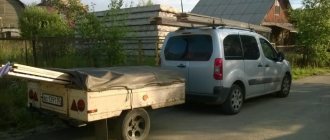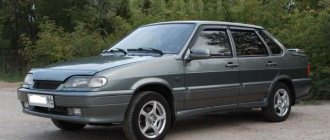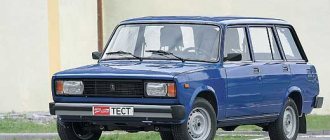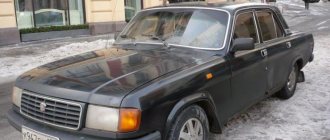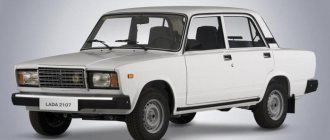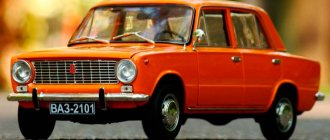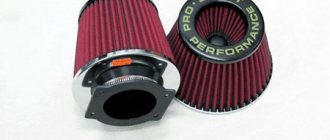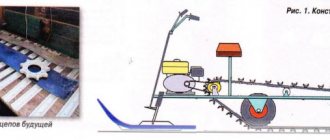How much does the VAZ weigh?
Perhaps one of the most popular cars in the post-Soviet space was, is and remains the VAZ.
This car has captivated many generations. However, how did it all begin? When was the first VAZ car produced and how much did it weigh? You will learn the answers to these and other questions from this article. The first VAZ car was produced by the Volzhsky Automobile Plant on April 19, 1970. The make of this car was VAZ-2101 Zhiguli. Its production was carried out according to the analogue of the Fiat concern. Moreover, the VAZ owes its appearance to this particular brand of the Fiat 124 car produced in 1966. Here, in fact, is it: As a result of some design improvements, the first domestic car, the VAZ 2101 of 1970, was produced:
The weight of this car was 955 kg. Moreover, of this mass the engine weighed 114 kg.
It has not lost its popularity to this day. In 2000, it was recognized as the best car among eighty thousand car enthusiasts surveyed in the CIS countries and Russia. It was named the best car of the century, VAZ 2101. At the time of its production, it was considered the most comfortable, reliable and modern domestic car. Its presence was a sign of wealth and prosperity!
But the Volzhsky Automobile Plant did not stop there. He created entire collections of this car. Each of them differed in its configuration, as well as its total weight. Therefore, now we will compare some VAZ models by their weight.
- VAZ 2102 has a weight of 1010 kg .
- VAZ 2103 has a weight of 965 kg .
- VAZ 2104 has a weight of 1020 kg .
- VAZ 2105 has a weight of 1060 kg .
- VAZ 2106 has a weight of 1045 kg .
- VAZ 2107 weighs 1049 kg .
- VAZ 2108 weighs 945 kg .
- VAZ 2109 weighs 915 kg .
- VAZ 2110 has a weight of 1020 kg .
- VAZ 2111 has a weight of 1055 kg .
- VAZ 2112 has a weight of 1060 kg .
- VAZ 2113 weighs 975 kg .
- VAZ 2114 weighs 985 kg .
- VAZ 2115 has a weight of 1000 kg .
- VAZ 2116 weighs 1276 kg .
- VAZ 2117 has a weight of 1110 kg .
- VAZ 2118 has a weight of 1110 kg .
- VAZ 2119 has a weight of 1110 kg .
- VAZ 2120 has a weight of 1110 kg .
- VAZ 2121 has a weight of 1550 kg .
- VAZ 2122 has a weight of 1122 kg .
- VAZ 2123 has a weight of 1300 kg .
But this is the total weight of a VAZ car. As for some parts of the car, the weight of, for example, a VAZ 2106 can be decomposed as follows:
- The weight of the engine with equipment is 140 kilograms .
- The weight of the gearbox is 26 kilograms .
- The weight of the square shaft is 10 kilograms .
- The weight of the rear axle is 52 kilograms .
- Radiator weight – 7 kilograms .
- Body weight – 280 kilograms .
On average, the weight of all components of a VAZ car has approximately the same mass. Throughout the entire period of existence of this car, quite interesting facts have been recorded that simply cannot be ignored. It’s hard to imagine that a car weighing an average of 1 ton is very popular.
So, the VAZ 2121 Niva car is not only the most popular throughout the USSR, but also the most exported. Just imagine, this model was produced in 1.8 million cars. And of this amount, 500,000 were sold to more than 100 countries. As we remember, the weight of the VAZ 2121 is 1550 kilograms . This means that over the entire period, 775,000,000 kilograms of this car were sold! Also, this particular model of all Soviet cars was driven in Japan. As for the design of the VAZ 2108, it was developed by the currently well-known company Porshe. Its engine weighs 127.3 kilograms . This became necessary due to the fact that the demand for this brand of car was greatly reduced. For this reason, they decided to modernize it.
Moreover, the VAZ car became more popular because the Lada car was the first car of the famous Formula 1 racer - Kimi Raikkonen. His father loved this car extremely much for its reliability.
So, we learned that each VAZ car model has its own separate weight. But throughout the history of its existence and production, it has not undergone major changes.
VAZ engine malfunctions and their symptoms
No matter how reliable the power unit of the “penny” is, it can also sometimes be capricious. The main signs of its malfunction are:
- inability to start;
- unstable operation at idle, tripping;
- reduction in traction and power characteristics;
- overheat;
- extraneous noise (knocking, clattering);
- the appearance of white (blue) exhaust.
Naturally, any of the listed symptoms cannot clearly indicate a specific malfunction, so let's look at them in more detail in the context of possible breakdowns.
The engine won't start at all
If, when you turn on the ignition and turn the key to the position at which the starter is turned on, the latter works, and the power unit shows no signs of life at all, this may be evidence of failure:
- ignition coils;
- distributor;
- breaker;
- ignition circuits;
- fuel pump;
- carburetor
If such a symptom is detected, you should not immediately change any of the ignition system components or disassemble the carburetor. First, make sure that voltage from the battery is supplied to the coil, distributor, distributor, and spark plugs. After this, you can begin diagnosing the fuel pump and carburetor.
Unstable operation at idle
In this case, the malfunction can also be caused by problems in two systems: power and ignition. Typical breakdowns accompanied by this symptom include:
- failure of the carburetor solenoid valve;
- clogging of the fuel filter at the inlet to the carburetor;
- clogged fuel or air jets;
- violation of regulation of the quality and quantity of the fuel-air mixture;
- malfunction of one or more spark plugs;
- burning of the contacts of the ignition distributor, distributor cap, slider;
- breakage of the current-carrying core (insulation breakdown) of one or more high-voltage wires.
Here, as in the previous case, it is better to start searching for the problem by checking the ignition system.
Reduced engine power
The power unit may lose its power characteristics due to:
- fuel pump malfunction;
- clogged fuel filter or fuel line;
- violation of regulation of the quality of the fuel-air mixture;
- increasing the gap between the breaker contacts;
- incorrect adjustment of valve timing or ignition timing;
- wear of piston group elements.
If you detect a decrease in the power and traction characteristics of the power unit, first check whether the timing marks of the gas distribution mechanism match, and also whether the ignition timing is set correctly. Next, you should make sure that the gap between the distributor contacts is adjusted correctly. After this, you can start checking the fuel pump, filter and carburetor. If a drop in engine power is accompanied by thick white smoke from the exhaust pipe, the appearance of an oil emulsion in the air filter housing is a clear sign of wear or damage to the piston parts.
Overheat
A violation of the normal temperature regime can be identified by observing the behavior of the arrow on the temperature indicator located on the vehicle’s instrument panel. When overheated, it moves to the red sector of the scale. In more complex cases, the coolant simply boils. Under no circumstances should you continue driving with such a malfunction. This will inevitably lead, at a minimum, to burnout of the cylinder head gasket.
Engine overheating can be caused by:
- thermostat malfunction (blocking the movement of fluid through the cooling radiator);
- breakdown of the water pump (pump);
- low level of coolant in the system (depressurization, leakage of coolant);
- inefficient operation of the radiator (clogged tubes, external lamellas);
- broken radiator fan drive belt.
Having discovered that the car’s engine has begun to overheat, the first thing you need to do is check the coolant level in the expansion tank. Next, you need to determine whether the thermostat opens to a large circle. To do this, just touch the radiator pipes. With a warm engine they should both be hot. If the top one is hot and the bottom one is cold, the thermostat is faulty and needs to be replaced.
It is almost impossible to determine if the pump is faulty without dismantling it, so it is better to leave this option for last. But the performance of the fan is easy to determine. The “penny” has a permanent drive. Its impeller is driven by a V-belt from the crankshaft pulley. By the way, this belt also ensures the operation of the water pump, so if it breaks, two components of the cooling system will fail at once.
Extraneous noise in the engine
A car engine itself is a rather complex mechanism that produces many different sounds during operation. It is impossible for an uninitiated person to determine by ear a malfunction of the power unit, but a specialist, even without additional equipment, can tell you which sound is unnecessary and what kind of breakdown it indicates. For the VAZ 2101, the following extraneous sounds can be distinguished:
- valve knocking;
- knocking of main or connecting rod bearings;
- clatter of piston pins;
- loud rustling of the timing chain.
Valve knocking can occur due to increased clearance in the valve mechanism, wear of the valve springs, and wear of the camshaft cams. A similar problem is solved by adjusting the valves, replacing springs, restoring or replacing the camshaft.
The crankshaft main and connecting rod bearings may also make knocking noises. Such a malfunction may indicate low oil pressure in the system, increased clearance between the bearings and connecting rod journals, or severe wear of the bearings themselves.
Piston pins usually knock for one reason - incorrectly set ignition angle. Their knocking indicates that the fuel-air mixture ignites too early, which causes detonation in the combustion chambers. It is enough to “delay” the ignition a little by turning the distributor clockwise, and the problem will disappear.
The timing chain cannot help but rustle while driving, but an excessively loud sound is a sign of either stretching or a broken damper. Such a breakdown can be eliminated by replacing the damper or tensioner shoe.
Thick white exhaust
A serviceable engine practically does not smoke in dry weather. In frost or rain, the exhaust becomes noticeably denser due to condensation. This is absolutely normal. But if thick white (in some cases bluish) smoke comes from the exhaust pipe, regardless of weather conditions, most likely there is wear on the piston rings, and perhaps on the pistons themselves and the cylinder walls. In this case, the oil enters the cylinders and burns, and the oil that does not burn is expelled through the carburetor into the air filter housing. It is the burnt grease that creates that white smoke. In addition, when parts of the piston group wear out, exhaust gases can enter the lubrication system, creating excess pressure there. As a result, oil may even leak out through the dipstick hole. There is only one way out - a major overhaul of the engine.
But that's not all. White exhaust is also a sign of cylinder head gasket damage, in which coolant circulating in the cooling jacket enters the combustion chambers. This malfunction is almost always accompanied by exhaust gases entering the expansion tank. So, if you see white smoke, don’t be too lazy to look into the tank. The smell of the exhaust and air bubbles will point you in the right direction to find the problem.
VAZ for scrap metal
The First Scrap Metal Company is no longer alone in accepting old cars. By concluding a deal with us, you will not have to tediously wait for your funds. We work around the clock and are ready to accept your order immediately.
Please note: scrapping a car is not only a profitable decision, but also the right one from the point of view of protecting the environment.
How we are working
To begin with, the car is sent to a plant that processes metals. This is where they begin to separate old batteries, rubber and wiring from the car. After this, the parts are sent to the dismantling workshop. If there is any remaining gasoline in your car, it must be poured into a canister designed for this purpose. A completely disassembled car is just a pile of metal that will be sent to metal crushing equipment.
Everything that remains of the car is melted down. Recyclable materials will be simply an excellent source for making bodies for new cars. If you decide to sell your VAZ 2106 for scrap metal, you can:
- earn;
- clear the area around you of debris;
- contribute to improving the environmental situation;
- help in obtaining recyclable materials.
Documents needed to scrap a car:
- you must have a civil passport with you;
- passport of the car that is about to be scrapped;
- document authorizing disposal from the traffic police.
If you cannot deliver the car to the collection point yourself, then we will do it for you using special equipment for its delivery. We have a fleet of special vehicles for this!
The most frequently asked question is how much does a VAZ cost for scrap metal?
— We answer:
Features of car recycling
Before you scrap your car, you should familiarize yourself with the principles of this procedure. The average weight of a vehicle is 1000 kg. If the entire car can be recycled, the collection point will deduct 30% for clogging. The latter includes all non-metallic elements, pollution, etc.
Let's consider how much a car for scrap metal weighs using the example of a VAZ 2105. The weight of the latter is 955 kg. Thus, taking away the blockage, we get about 660 kg. You should also take into account the price of scrap, which differs depending on the city. As a rule, in megacities, the number of rubles received for a car will significantly exceed the amount earned in a similar organization in a small locality.
Before calculating the profit from a scrapped car, you need to take into account transportation costs. If the car is a pile of metal, you need to take care of a tow truck. If there are spinning wheels and functional steering, the car can be transported in tow. Then, this expense item will not be so significant. Therefore, in order to calculate how much a Zhiguli costs when scrapped, it is not enough to know how much a VAZ 2109 or 21099 weighs for scrap metal (915 kg). It is necessary to take into account the features of recycling and the requirements of collection points. It would be useful to know the average cost of scrap metal in the region. Additional awareness will allow you to avoid fraud on the part of unscrupulous receivers.
Do-it-yourself painting and restoration of the VAZ 2101 body
For almost three decades, the legend of the domestic automobile industry, the VAZ 2101, practically dominated the roads of the vast country. Technical characteristics, handling, dynamics, a comfortable interior and a “penny” price ensured that it was in great demand among car enthusiasts. Even today it is not uncommon on the roads of the post-Soviet space.
The main problem of the VAZ 2101 is considered to be the body, as time, chemicals on the roads and humidity take their toll. Considering how much time has passed since the last car was released (and this happened in 1988), repairs, painting and other restoration work are a pressing issue for owners of a “penny”.
Due to its great popularity, it is quite easy to find spare parts and parts for this model. This is important because, given the age of the car, sooner or later the owner of the model will have to face a complete restoration of the body.
How much do the car frame and body parts weigh?
The VAZ 2101 has a monocoque body on which all the components and elements of the car are located. This means that the body absorbs all static and dynamic loads of the components and assemblies attached to it. With this type of body, the frame material is very important.
How much the body of a “penny” weighs depends on what it is made of. The fact is that strengthening weak points and increasing the mass of the frame lead to increased load on structural parts and elements.
To reduce the weight and cost of the car, non-load-bearing elements are made of thinner metal. The most important structures for strength have a thickness of about 1 mm, that is, at the level of modern vehicles of similar class.
You can find out how much the body weight of a “penny” is by adding up the mass of its elements:
- power unit with attachments, weight – 140 kg;
- rear axle, weight – 52 kg;
- gearbox, weight – 26 kg;
- cardan shaft, weight – 10 kg;
- radiator, weight – 7 kg;
- bare body of VAZ 2101 – 280 kg.
Car history
The creation of “2101” was preceded by a whole chain of organizational and technical measures, from the founding of the plant itself, to cooperation with various foreign companies and, first of all, with the Italian FIAT plant.
Photo of a penny
It was the FIAT 124, which was recognized as the most popular, that was supposed to become the prototype of the new Soviet car. But in the process of developing a new concept and testing the FIAT 124, a discrepancy between the technical characteristics of the latter and the road conditions in the Soviet Union was revealed:
- With intensive use, the body and weak suspension did not provide the required strength;
- The ground clearance was low and did not meet off-road requirements;
- There were no elements that would ensure towing the car if it breaks down on the road.
VAZ-2101
As part of close cooperation, Italian engineers took an active part in the development of the new model and more than eight hundred changes were made. For example:
- The rear wheels received drum brakes, suitable for bad roads;
- The rear suspension design has been completely changed;
- The front suspension has been strengthened;
- The clutch has been strengthened and the operation of the synchronizers of the “2101” gearbox has been improved;
- The salon could become a sleeping area, thanks to the transformation of the seats;
- A new overhead shaft engine was installed.
As a result, only the appearance remained in the new car from the Italian one. Tests carried out with the first six vehicles showed reliability and good maneuverability, so subsequent improvements were minor.
Photo of VAZ-2101
The history of the names is interesting . “2101” received the official name “Zhiguli” after the name of the small mountains beyond the Volga not far from the automobile plant, which is located in the city of Tolyatti.
The people gave the car a simple, respectful, memorable name “unit”. Later in the 80s, amid a decline in prestige, it received the name “kopek”. Years of production: 1970 - 1982. In total, more than 2.7 million copies were produced during this time.
Characteristics of the VAZ 2101 body
How long the housing will last depends not only on the thickness of the metal sheet, but also on the quality of the anti-corrosion protection.
The result was secured with a layer of soil applied by electrophoresis, and the bottom of the car was covered with a layer of special strengthening mastic. The result of all this is that the VAZ 2101 remains an equal participant in road traffic to this day. The interior of the “penny”, or rather, its protruding parts: handles, visors, levers, is equipped safely. In car markets and online stores you can easily find all the necessary spare parts if you need to replace them.
The cabin has an ergonometric driver's seat, good thermal and noise insulation, fresh ventilation, i.e. everything that creates comfortable conditions for those in it. The interior is equipped in such a way that there are no blinding elements or parts in the driver’s field of vision.
The outer surfaces of the case do not have protrusions or sharp edges. "Kopek" rear-view mirrors provide excellent visibility. Mirrors, headlights and other elements are most often exposed to mechanical stress and require replacement. Mirrors, like other spare parts, can always be purchased inexpensively at the car market.
Interesting! Many car owners install chrome-plated exterior mirrors on the 2101.
The design of modern rear-view mirrors makes it possible to install them on any car. Look about tuning the VAZ 2101:
Advantages and disadvantages
- Relative internal comfort;
- Good heating in winter;
- Good ventilation, sound insulation,
- Trouble-free engine starting in cold weather;
- Economical, cheap, easy to repair;
- Spacious interior, roomy trunk.
- Smooth ride, good dynamics.
- Poor seat ergonomics;
- Lack of active safety;
- Limited resource until overhaul;
- No power steering;
- Low average speed;
- Low anti-corrosion protection;
- Insufficient rigidity of the car body;
- Low camshaft resource.
The main reasons why frame parts rot
One way or another, over time, any vehicle requires body restoration work. This happens for the following reasons:
- defects arising from mechanical impact on the body;
- operating the vehicle in urban environments, where the presence of chemicals on the roads is inevitable;
- constant condensation caused by sharp fluctuations in ambient temperature (if the car is stored outside the garage);
- Moisture accumulates under car tuning elements, leading to corrosion;
- Infrequent vehicle washing leads to the accumulation of dirt and moisture in various cavities of the structure.
Most often, rust appears in certain areas of the body, of which there are not so many, but often these are hard-to-reach places where moisture accumulates and does not evaporate: wheel arches, doors, sills, trunk lids and hood.
Body repair, its complexity and the necessary tools depend on the extent of the spread of corrosion processes, which are of the following types.
Let us consider in detail the stages of body work in the presence of a point of corrosion. To make such repairs yourself, you must have at least basic plumbing skills. But even if you have never done this type of work, if you have the desire, patience and our instructions, you can repair the car body yourself.
Useful! When assessing the degree of damage, take into account the following: if pockets of corrosion have appeared on the central pillars, in the joining areas of the sub-engine frame, side members and other power elements, no amount of repair and subsequent painting will save the situation. The right step would be to completely replace the case.
Conventional flywheel
No matter what anyone says, this is a fairly calibrated part that is calculated for loads, torsion, and even breakdown.
Usually its weight ranges from 7 to 9 kilograms. It all depends on the model and class of the car (I don’t take trucks, they weigh much more).
After the engine is started, a conventional flywheel gains kinetic energy from the operation of the motor. Therefore, when the engine is running, some part is spent on its promotion and further rotation. Moreover, the heavier this “disk” is, the more energy needs to be spent. This especially affects high speeds, where energy consumption increases in a quadratic progression, starting from 4500 revolutions.
That is, it turns out that the flywheel, as it were, interferes with the operation of the engine, taking away some of its energy for its spin-up. However, not everything is so simple here - due to its weight, this element absorbs various unnecessary energies caused by engine detonation or some other side processes. Thus, they do not go into the body, but are sort of “absorbed”, which is not unimportant!
Body dimensions: checking car geometry
Repair work to restore the VAZ 2101 body should begin with checking its geometric dimensions.
The geometry of the body can be disrupted as a result of various mechanical influences, loss of rigidity and elasticity of rusty structural elements. To ensure that the vehicle's geometry corresponds to its original parameters as a result of restoration work, check the control points specified in the vehicle's operating instructions. How many mm of taper is allowed will be answered by the manufacturer, who determined the unevenness of the gaps to be 1.5 mm.
If the tolerances for the front elements of relatively fixed structures are more than 2 mm, then restoration of the geometry of the frame is required, which is carried out in auto repair shops using special equipment - a slipway. If there are no serious discrepancies in the geometric dimensions, measured and certified, you can proceed to the next step - welding work.
Specifications
| Positions | Indicators | |
| VAZ 2101 | VAZ 21011 | |
| Type of fuel | Gasoline A-76, AI-92 | Gasoline AI-93 |
| Injection device | Carburetor | |
| Cylinder block material | Cast iron | |
| Cylinder head material | Aluminium alloy | |
| Weight, kg | 114 | |
| Cylinder arrangement | Row | |
| Number of cylinders, pcs | 4 | |
| Piston diameter, mm | 76 | 79 |
| Amplitude of piston movement, mm | 66 | |
| Cylinder diameter, mm | 76 | 79 |
| Working volume, cm3 | 1198 | 1294 |
| Maximum power, l. With. | 64 | 69 |
| Torque, Nm | 87,3 | 94 |
| Compression ratio | 8,5 | 8,8 |
| Mixed fuel consumption, l | 9,2 | 9,5 |
| Declared engine life, thousand km. | 200000 | 125000 |
| Practical resource, thousand km. | 500000 | 200000 |
| Camshaft | ||
| location | top | |
| valve timing width, 0 | 232 | |
| value of the exhaust valve advance angle, 0 | 42 | |
| intake valve retard, 0 | 40 | |
| diameter of seals, mm | 56 and 40 | |
| width of seals, mm | 7 | |
| Crankshaft | ||
| Neck diameter, mm | 50,795 | |
| Number of bearings, pcs | 5 | |
| Flywheel | ||
| outer diameter, mm | 277,5 | |
| bore diameter, mm | 256,795 | |
| number of ring teeth, pcs | 129 | |
| weight, g | 620 | |
| Recommended Engine Oil | 5W30, 15W40 | 5W30, 5W40, 10W40, 15W40 |
| Engine oil volume, l | 3,75 | |
| Recommended Coolant | Antifreeze | |
| Coolant quantity, l | 9,75 | |
| Timing drive | Chain, double row | |
| Cylinder operating order | 1–3-4–2 | |
Welding and soldering rotten body parts
All heavily rusted removable elements are dismantled for subsequent replacement with new parts.
The places where parts are attached to the body are thoroughly cleaned with sandpaper, degreased and primed. If you still were unable to find any spare parts and components, then the damaged element will have to be restored. For this you may need an angle grinder, autogen, spotter, and straightening tools. Deformed areas of the surface can be restored in various ways, for example:
- using special levers;
- using applicators using adhesive or vacuum technology from the outside;
- using a magnet;
- by heating followed by cooling.
If you need to connect sections or structures in unimportant locations, you can use the soldering method:
- Coat the contact points of the parts with solder, heat and connect.
- Place solder in the joint area and heat it with a gas torch or a powerful soldering iron.
Use special flux and solder for soldering, since ordinary tin will not provide a strong and reliable connection of parts.
When replacing a spare part is a time-consuming or impractical procedure, and the structure is rotten in one place, you can install a patch made of new metal. After you have restored the deformed areas of the car body, the final stage of the overhaul follows - painting.
How much copper is in an electric motor and how to make money from it
Good afternoon There are a lot of options for earning extra money. Some lie on the surface, some are difficult to achieve or even unrealistic for some regions, people and other conditions.
On the Internet, you can often find advertisements for the purchase of old and non-working electric motors. The price for this, I apologize, scrap metal in our region varies from 25 to 30 rubles per kilogram. Electric motors are purchased both by scrap metal collection points and by private traders.
Today, using a specific example, I will find out how profitable such an activity as buying electric motors, disassembling them and selling the non-ferrous metals that make up them is. It must be said that on average the share of copper in the total mass of an electric motor is about 10%. This is where the average purchase price for electric motors comes from.
I have two small electrics in my garage. engine, one of which I donated for the experiment.
Disassembling such an electric motor with carefully unscrewing all the bolts and nuts took a little less than 30 minutes.
Here's what happened (calculation at the end of the article):
So let's start counting. If you buy el. a complete engine at a price of 30 rubles/kg will have to pay 112.5 rubles
. Now let’s calculate what we managed to get:
Copper in the form of wire 0.4 kg - subtract the standard 5% of blockage on the varnish, we get 0.38 kg, multiply by the average price of copper 330 rubles / kg (in our region the price ranges from 310 to 350 depending on the volume and season) we get 125.4 ruble
only for copper.
But we still have the housing and the unassembled rotor. The electric motor housing is made of aluminum and at the reception it goes like this - aluminum motor at a price of 60 rubles / kg, multiply by 0.725 - 5% we get 41 rubles.
Well, the rest is ferrous metal (I didn’t disassemble the rotor - you can also extract the copper, but you have to burn it) 2.45 at 10 rubles / kg = 24.5 rubles.
Expenses: purchase 112.5 rub. + disc for grinder 20 rub. (enough for 5 such motors) = 132.5 rubles
Income: 125.4+41+24.5 = 190.9 rubles
net profit: 58 rubles
It seems like a penny, but in relation to investments the yield is approximately 44%. No bank gives such interest per annum, but here it is in one day.
Of course, for a more or less good break-in, you need to buy dozens of motors or larger ones every day. But you can accumulate them, wait for a good price for copper and aluminum and hand them over twice a year, because the percentage is not bad at all, you only need volumes.
Source
Do-it-yourself painting of body parts
Before you start painting the VAZ 2101, you need to level the repaired surfaces using putty.
This is a very important procedure, on which the final result directly depends - painting, its appearance and protective properties. To level the surface before painting the car, prepare the composition: mix the putty with the hardener (how much hardener should be taken is indicated on the consumable label) until a homogeneous mass is obtained. Now use a rubber spatula to apply the mixture to the surface. After drying, the treated areas should be sanded smooth.
Your next step is to apply a primer. This procedure promotes better adhesion of car enamel to metal, as a result of which the painting will provide a more durable, wear-resistant and reliable coating of the car body.
You can apply the paint yourself with a roller, brush or using a spray gun. The latter option will provide a higher-quality coating layer and reduce working time.
Body weight
Let’s say right away that the “six” weighs exactly 1045 kg. Its mass is decomposed as follows:
- The weight of the power unit together with additional equipment is 140 kg;
- The gearbox weighs about 26 kg;
- Shaft – 10 kg;
- Rear axle – 52 kg;
- Radiator – 7 kg;
- Body – 280 kg.
It turns out that the body is the heaviest part of the car. It is exactly twice as heavy as the engine. The remaining parts of the machine have approximately the same mass.
